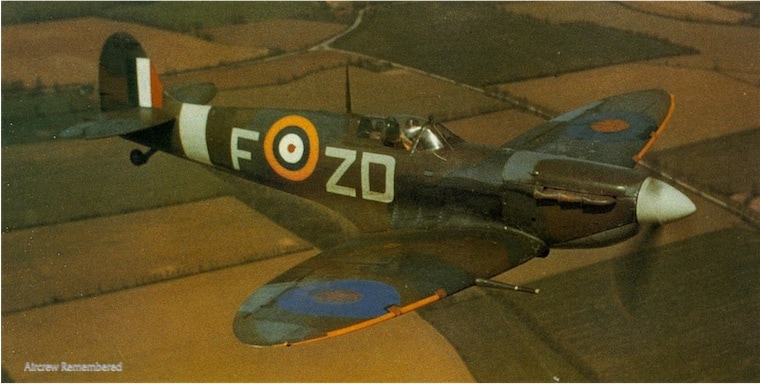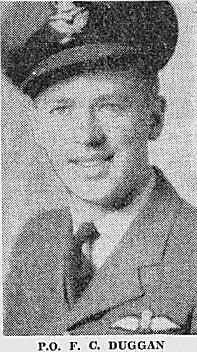It’s been a century since Niagara-on-the-Lake’s iconic clock tower cenotaph was erected. Then, in 1926, the Township of Niagara unveiled its own memorial in Queenston. In recognition of those who fought and died in two world wars and beyond, NOTL historian Ron Dale has been researching the stories of the people – all men – whose names are engraved on the two cenotaphs. This is one in a series of stories documenting and remembering the sacrifices of those commemorated on the municipal memorial in Queenston.
Ron Dale
Special to The Lake Report
It was a cold and cloudy day in England on Jan. 25, 1942.
A flight of Spitfire VB fighter aircraft of 222 Squadron of the Royal Air Force took off from the Stapleford Tawney Airbase in Essex on a practice flight that led over the wilderness area of Orford Ness in Suffolk, flying close to coast of the English Channel.
About five kilometres east of Orford Ness, the aircraft ran into heavy cloud. The Spitfires descended more than 6,000 ft through the cloud and two of the pilots reported “severe icing conditions, their engines were tending to cut and miss.”
The thick cloud also made it impossible for the pilots to see the other planes as they flew to get under the cloud cover.
The pilot of one of the Spitfires, Pilot Officer Fred Duggan, radioed base calling for an emergency homing signal. He was lost and needed guidance to the nearest landing field.
He was never heard from again.
The debris from his plane and his body were never recovered. He was declared “missing, believed dead,” the first man from present-day Niagara-on-the-Lake to die in the Second World War.
It was presumed his engine iced up and seized and that he crashed into the English Channel.
On Nov. 28, 1942, the Air Ministry issued a “Notification of Death” stating that Duggan “was reported missing and is presumed, for official purposes, to have lost his life on the 25th day of January, 1942, as the result of air operations.”
Frederick Charles Duggan was born in St. Davids on Feb. 17, 1920, son of Dr. Charles Duggan and Jessie Moore Hume. He had two older brothers, Hume and Richard, and a younger brother, David, who died in 1938 at the age of 15.
Fred Duggan attended St. Davids Public School from 1926 to 1932 and then Stamford Collegiate.
After graduation he was hired by the Cyanamid Company in Niagara Falls. In high school he had studied agriculture along with ancient history, math, geometry and Latin.
With an emphasis on agriculture in school and the job at Cyanamid manufacturing fertilizer, he was interested in farming after the war.
Duggan was a big man and very fit, though wiry, at 6 foot 1 and 145 pounds. He was a sportsman, playing rugby, basketball, tennis, badminton, baseball and golf.
He joined the Royal Canadian Air Force on Nov. 11, 1940, determined to fly.
His first appointment was to the Manning Depot in Toronto where he learned basic drill and deportment, the fundamentals of military training. On Dec. 12, 1940, he was transferred to flight school in Toronto to learn the rudiments of flying.
There he was described by his instructors as a “steady, dependable, clean-cut airman. Easy-going casual, but pleasant and cheerful in manner.”
In March, Duggan was sent to the Elementary Training School at St. Eugene in eastern Ontario and in May he was transferred to the Advanced Flying Training School in Dunnville.
In July he received his wings as a qualified fighter pilot.
On Aug. 19, 1941, h was ordered to Halifax to proceed overseas, arriving in England on Sept. 7. Prior to embarking he had successfully applied for a commission in the RCAF and was promoted to pilot officer.
In England, Duggan was sent to the Operational Training Unit at RAF base Grangemouth for further training in combat manoeuvres and formation flying and on Oct. 28, 1941, was posted to 222 Squadron of the Royal Air Force.
His squadron flew several patrols over England, prepared to intercept German bombers. They also flew training missions, practising formation flying and combat tactics.
The Spitfires of 222 Squadron had recently been fitted with new Merlin engines and there were still bugs to be worked out to ensure that they performed as required.
This may have been a contributing factor in the failure of the aircraft and Duggan’s death. We will never know.
Fred Duggan is commemorated on the cenotaph in Queenston. His name also is inscribed on the Runnymede Air Forces Memorial near Egham, Surrey, England, along with the names of 20,449 airmen from the Commonwealth who have no known grave.











